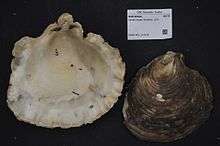Ostrea angasi
| Ostrea angasi | |
|---|---|
 | |
| Scientific classification | |
| Kingdom: | Animalia |
| Phylum: | Mollusca |
| Class: | Bivalvia |
| Order: | Ostreoida |
| Family: | Ostreidae |
| Genus: | Ostrea |
| Species: | O. angasi |
| Binomial name | |
| Ostrea angasi Sowerby, 1871 | |
The southern mud oyster, Australian flat oyster, native flat oyster, or angasi oyster (Ostrea angasi), is endemic to southern Australia, ranging from Western Australia to southeast New South Wales and around Tasmania. Ostrea angasi superficially resembles Ostrea edulis and both species may be referred to with the name “flat oyster”. However, the two species do not occur naturally in the same geographic distribution.
Habitat
This species is found in sheltered, silty or sand-bottomed estuaries at depths between 1 and 30 m.
Diet
Flat oysters, like all other oyster species, are filter feeders, feeding on, and taking in anything small enough to be filtered in their gills. This may include plankton, microalgae or inorganic material.
Predators
Oyster growers at Coffin Bay, South Australia have observed stingrays eating their experimental commercial stocks of Ostrea angasi.[1]
Commercial harvesting
Extensive oyster reefs in southern Australia were largely destroyed by over-exploitation during the 19th and early 20th Centuries. Oysters were dredged directly from the seabed.[2][3]
In the 21st century, commercial oyster growers in southern Australia have started experimentally farming O. angasi as a means to diversify their businesses. This was prompted by other growers suffering massive stock losses of Crassostrea gigas resulting from outbreaks of Pacific Oyster Mortality Syndrome (POMS).[1]
References
- 1 2 "High export hopes for forgotten native Australian oyster". ABC News. 2014-06-14. Retrieved 2017-02-23.
- ↑ National Library of Australia > Trove: Oyster beds. South Australian Register, 15 December 1884. P 4. Accessed 8 May 2015.
- ↑ Alleway, H. K. and Connell S.D. (2015): Loss of an ecological baseline through the eradication of oyster reefs from coastal ecosystems and human memory. Conservation Biology, Society for Conservation Biology. DOI: 10.1111/cobi.12452
External links